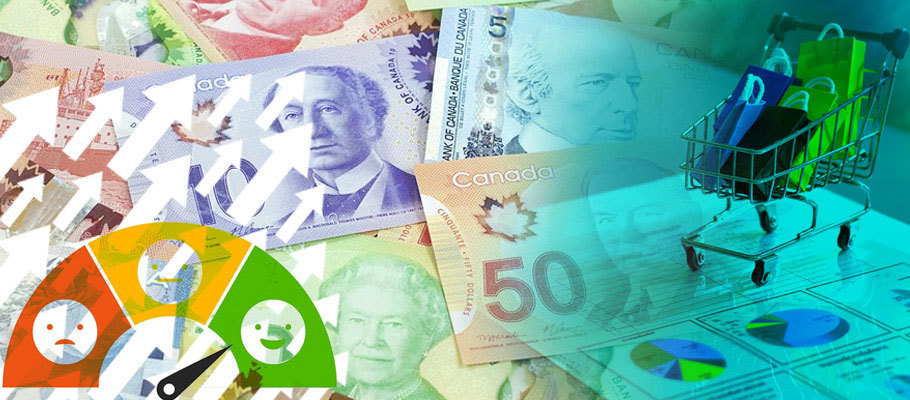
Published: May 24th, 2023
While the Loonie finished last week (wc 15th May) as an underperformer amongst G10 majors, a new economic print showing Canadian consumer spending to be resilient, may give it a boost.
CAD climbed alongside the Greenback after publication of Statistics Canada data that captured strong retail sales in March, helping underpin growth expectations for North America’s second-largest economy.
Though sales figures were down -1.39 per cent in overall terms for March when big ticket purchases like cars were included in the calculation, sales volume fell by a lesser -0.98 per cent, which suggests widespread discounting by main street shops.
That led to the cash value spending growth of 0.3 per cent in March when sales of cars, petrol, and repair parts were excluded. Overall sales look to have rebounded by 0.2 per cent the following month.
'The drop in March retail sales, and the incremental rebound in April points to Canadian consumers starting to feel the impact of higher interest rates,’ said economists at RBC in Toronto in an analyst commentary following publication of the data.
While RBC number crunchers may have been underwhelmed by the data, CAD bulls may take come consolation from the fact that the Canadian economy benefitted from widespread discounting that helped keep sales volumes aloft for the first quarter as a whole.
The distinction is significant. It’s sales volumes (as opposed to values) that are measured in calculations of a country’s economic output. It means consumer spending probably helped sustain Canada’s economy through the opening quarter of the year and stopped it from contracting.
The Loonie got an earlier boost in February by figures showing Canada's labour market was undergoing its strongest expansion since February 2022.
GBP/CAD stepped back from a brief multi-month rally above September's all-time low, however analysts think it could still settle above recent moving averages if official data from the UK side point to a healthy British labour market.
'Recent Canadian labour market numbers won’t change the perception of economic overheating,’ said HSBC’s FX Strategy Unit in a Monday market analysis. 'While the number of new jobs created was surprisingly high, wage growth also stayed above four per cent.’
'The year-on-year wage rise of 4.4 per cent in January was the lowest posted since July, however the Bank of Canada believes that wage growth needs to fall below four per cent to keep inflation at its target two per cent ceiling.’
The Loonie started the week as an outperformer but a 150,000 rise in employment offset by softening wage growth sends mixed signals about the likely direction of Bank of Canada (BoC) interest rate policy.
Canada’s central bank said in January that the cash rate would probably stay at its current 4.25 per cent for the near term while BoC economists consider the impact of last year's rate rises on the domestic economy. That points to the possibility of last Friday's data being effectively set aside as a blip by Ottawa rate setters.
Sean Osborne, chief currency strategist at Scotiabank in Toronto, told Reuters that the limited number of data releases from Canada this week and next meant eyes would be focused on new US data, with investors looking for inflation and its impacts.’
In late 2022, analysts at Bank of Montreal (BMO) said that sliding oil prices were temporarily holding the Loonie back, but that an oil price recovery was expected at some point in 2023. That would give CAD support.
‘The unexpected decline in oil prices (in late December 2022) has trickled through to currency markets in ways we would expect,’ wrote BMO in a December forex briefing. For the Canadian Dollar, that’s manifesting as underperformance linked to oil market dynamics. ‘The surprising shift in crude prices is hammering commodity currencies like CAD.’
In fact, the Loonie was amongst the biggest G10 losers that month, though it wasn’t alone. The Norwegian Krone, Europe's top petrocurrency, was also on the back foot.
BMO said all these moves confirmed the oil linkage. ‘What we are seeing is a broad rally for oil importing currencies while oil exporter currencies suffer.’
The Pound to Loonie (GBP/CAD) exchange rate rose for five weeks in a row, extending an appreciating trend that first emerged in September 2022.
‘Canada's dollar is being held hostage by oil market dynamics,’ said Scotiabank’s currency strategy unit in an analyst note. 'Oil exporting currencies were some of the weakest performers this week, reflecting investor worries that a global economic downturn is likely on the horizon.’
GBP/CAD’s spot price was 1.6767 in mid-December 2022, with international payment rates for a standard bank account holding at roughly 1.62.
Back in May 2022, the historic link between oil prices and CAD looked like it had been broken forever.
The Loonie slipped against the greenback despite a significant rally in oil prices. Analysts said at the time that the divergence in crude and CAD pricing would probably to be temporary, though it wasn’t the first time the traditional crude-Loonie link had been severed.
CAD dipped by around half a percentage point against the US dollar across most of 2022. That happened despite a 60 per cent increase in global crude prices and a 34 per cent gain for Canada’s benchmark Western Canada Select in the same time frame.
For investors who follow petrocurrencies like the Canadian Dollar and Norwegian Krone, there's an expectation that prices will rise and fall in proportion to crude oil prices. The price action seen in May 2022 severed that link.
Analysts at CIBC in Toronto, however, noted that the relationship between CAD and oil had been evolving for years. Many analysts, investors, and forex traders simply hadn’t come to the realisation yet that things had changed.